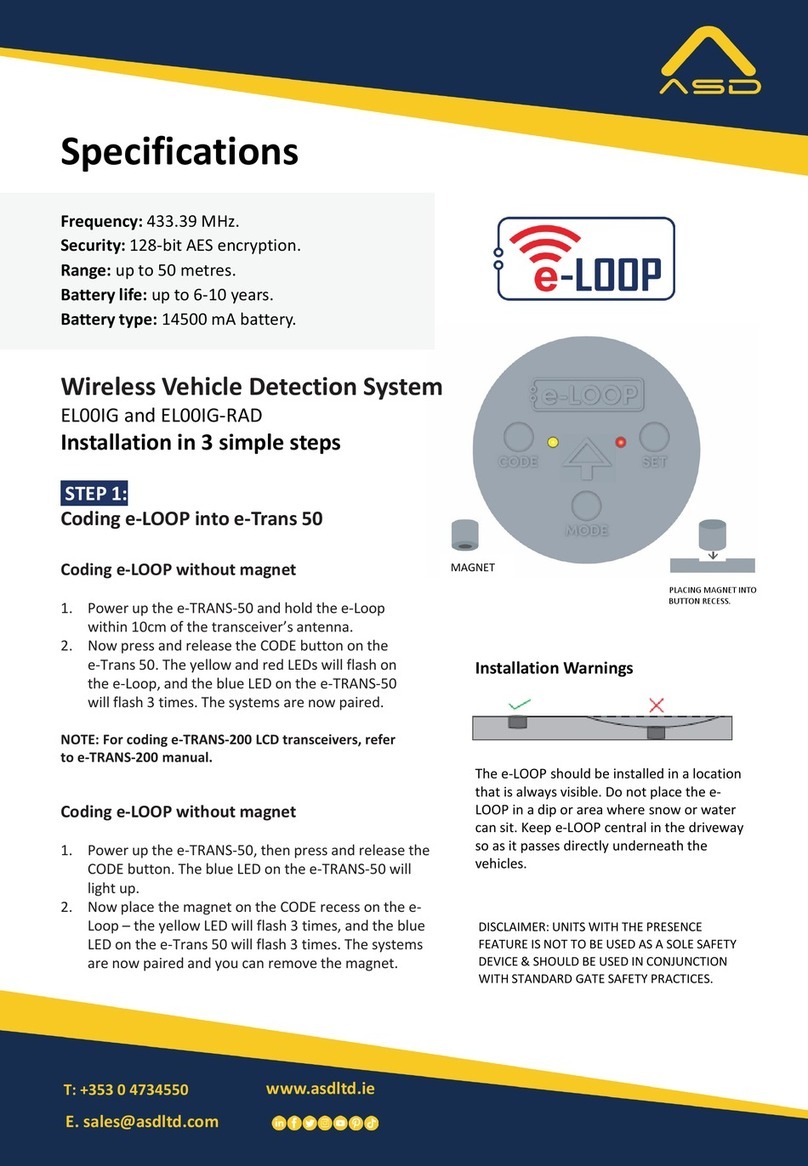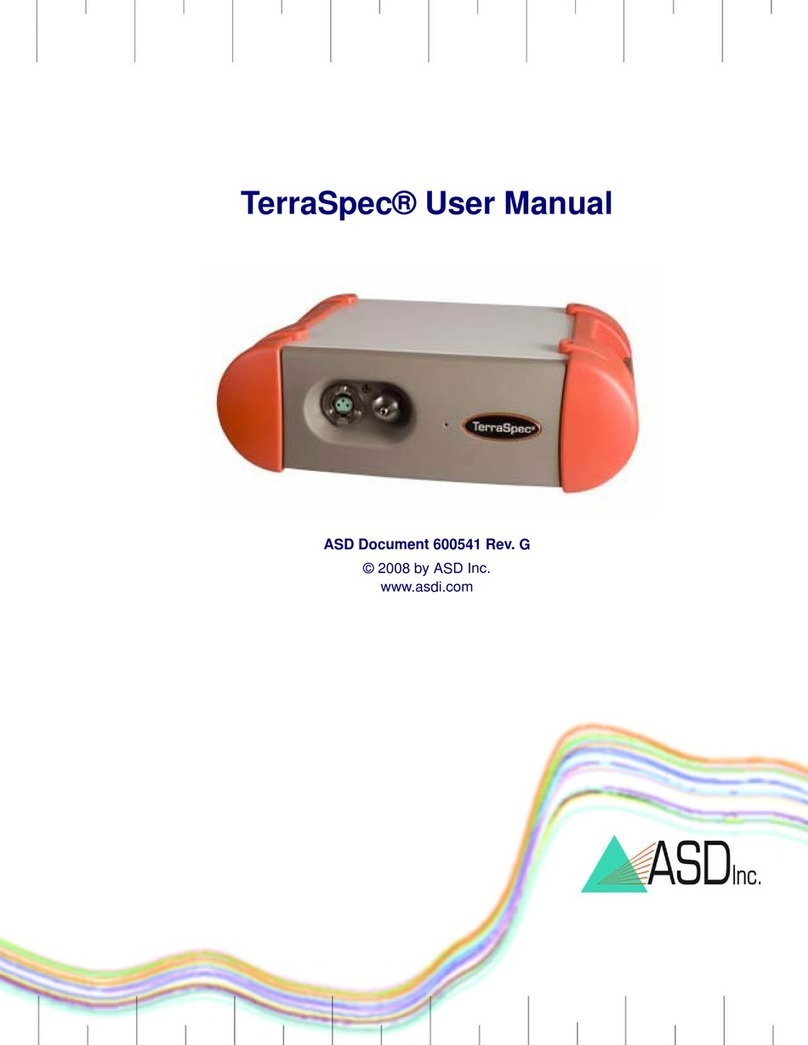
ASD Document 600540 Rev. J iv FieldSpec® 3 User Manual
www.asdi.com
Chapter 5 Batteries . . . . . . . . . . . . . . . . . . . . . . . . . . . . . . . . . . . . . . . . . . . . . . . . . . . . . . 37
Battery Care . . . . . . . . . . . . . . . . . . . . . . . . . . . . . . . . . . . . . . . . . . . . . . . . . 37
Battery Charger . . . . . . . . . . . . . . . . . . . . . . . . . . . . . . . . . . . . . . . . . . . . . . 38
Application Battery Indicator. . . . . . . . . . . . . . . . . . . . . . . . . . . . . . . . . . . . . 39
Chapter 6 Transporting and Carrying the FieldSpec® 3 . . . . . . . . . . . . . . . . . . . . . . . . 41
Packing FieldSpec® 3 for Shipment. . . . . . . . . . . . . . . . . . . . . . . . . . . . . . . 41
Preparing the FieldSpec® 3 and Ergonomic Pro-Pack for the Field. . . . . . . 46
Carrying Supplies . . . . . . . . . . . . . . . . . . . . . . . . . . . . . . . . . . . . . . . . . . . . . 52
Protecting the Instrument in the Field. . . . . . . . . . . . . . . . . . . . . . . . . . . . . . 53
Chapter 7 Field Measurements . . . . . . . . . . . . . . . . . . . . . . . . . . . . . . . . . . . . . . . . . . . . . 55
Illumination . . . . . . . . . . . . . . . . . . . . . . . . . . . . . . . . . . . . . . . . . . . . . . . . . . 56
Characteristics of Natural Illumination . . . . . . . . . . . . . . . . . . . . . . . . . . . . . 56
Characteristics of Artificial Illumination . . . . . . . . . . . . . . . . . . . . . . . . . . . . . 58
Atmospheric Characteristics. . . . . . . . . . . . . . . . . . . . . . . . . . . . . . . . . . . . . 58
Clouds . . . . . . . . . . . . . . . . . . . . . . . . . . . . . . . . . . . . . . . . . . . . . . . . . . . . . 60
Wind . . . . . . . . . . . . . . . . . . . . . . . . . . . . . . . . . . . . . . . . . . . . . . . . . . . . . . . 61
Vegetation. . . . . . . . . . . . . . . . . . . . . . . . . . . . . . . . . . . . . . . . . . . . . . . . . . . 61
Rocks, Soils, and Man-Made Materials . . . . . . . . . . . . . . . . . . . . . . . . . . . . 64
Experimental Design . . . . . . . . . . . . . . . . . . . . . . . . . . . . . . . . . . . . . . . . . . 65
Time of Day / Year . . . . . . . . . . . . . . . . . . . . . . . . . . . . . . . . . . . . . . . . . 65
Sampling Strategy . . . . . . . . . . . . . . . . . . . . . . . . . . . . . . . . . . . . . . . . . 65
Viewing Geometry . . . . . . . . . . . . . . . . . . . . . . . . . . . . . . . . . . . . . . . . . 66
Suggested Set-up. . . . . . . . . . . . . . . . . . . . . . . . . . . . . . . . . . . . . . . . . . . . . 66
RS3 Application . . . . . . . . . . . . . . . . . . . . . . . . . . . . . . . . . . . . . . . . . . . 66
Indico Application . . . . . . . . . . . . . . . . . . . . . . . . . . . . . . . . . . . . . . . . . . 67
White Reference. . . . . . . . . . . . . . . . . . . . . . . . . . . . . . . . . . . . . . . . . . . . . . 69
Spectralon Reflectance Data . . . . . . . . . . . . . . . . . . . . . . . . . . . . . . . . . 69
Maintaining Spectralon References . . . . . . . . . . . . . . . . . . . . . . . . . . . . 70
White Reference Procedures . . . . . . . . . . . . . . . . . . . . . . . . . . . . . . . . . 71
Appendix A Troubleshooting . . . . . . . . . . . . . . . . . . . . . . . . . . . . . . . . . . . . . . . . . . . . . . . . 73
Common Communication Fixes . . . . . . . . . . . . . . . . . . . . . . . . . . . . . . . . . . 73
Does Not Connect to the Spectrometer . . . . . . . . . . . . . . . . . . . . . . . . . . . . 73
Does Not Connect Wireless . . . . . . . . . . . . . . . . . . . . . . . . . . . . . . . . . . . . . 75
Does Not Connect to the Access Point . . . . . . . . . . . . . . . . . . . . . . . . . . . . 76
Spectrometer Loses its Wireless Connection . . . . . . . . . . . . . . . . . . . . . . . . 77
Wireless Interface is Disabled in the Netcfg Application . . . . . . . . . . . . . . . 77





























